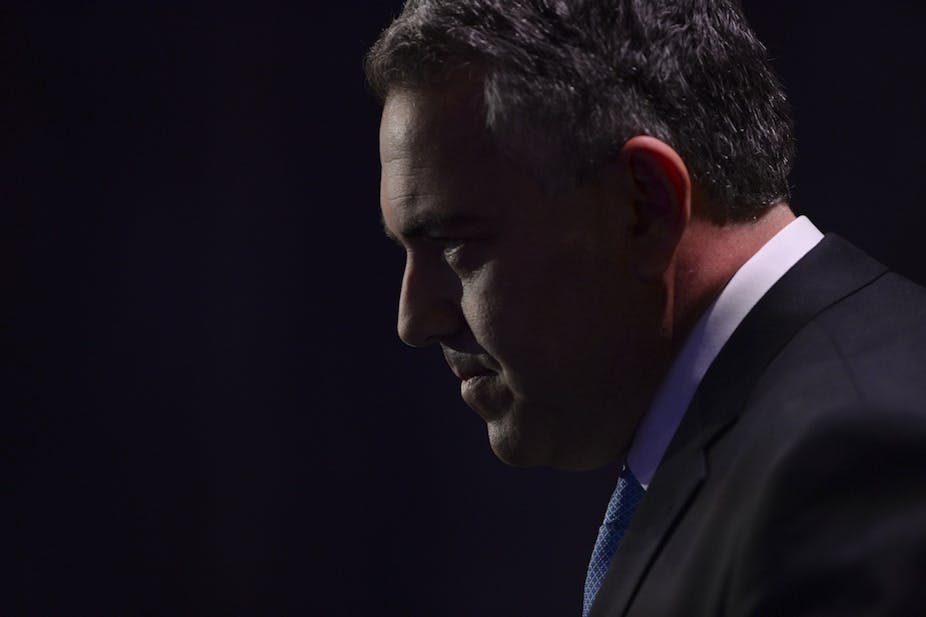Over the last few years our economic debate has focused on the budget deficit and government debt, displacing other aspects of economic policy. To Labor’s cost Wayne Swan made the deficit the centrepiece of his claim to economic responsibility, and in this year’s budget speech Treasurer Hockey continued to conflate fiscal and economic management when he said, without pause “… the time to fix the budget is now. The time to strengthen the economy is now”.
This obsession has been fuelled by Tony Abbott’s presentation of economic issues in three word slogans, and by a media seeking simple performance indicators. In economic policy there is a strong demand for that which is quantifiable, distracting attention from more meaningful but more nuanced sources of information.
In reality fiscal management is but one aspect of economic management. To take a business analogy, we would not judge a company purely on its capacity to manage its cash flow. We would want to look more deeply into a firm’s performance and plans. Just as we seek to know a firm’s business strategy, so do we seek to know a government’s economic policy.
For insight into a government’s economic policy, we need to go beyond the rhetoric of the budget speech and the “what’s in it for me” analysis put out by lobby groups and community organisations. That policy background is to be found, with some digging, in Budget Paper No. 1.
Indifferent to inequality
Notable in this year’s Paper 1 is the absence of reference to Australia’s government deficit or debt in comparison with other countries. Such data, as has appeared in previous editions of Paper 1, hardly supports the idea of a “budget emergency”. Treasury’s loyalty to its new masters is on display.
Also in this year’s Paper 1 is a new section “Sustaining strong growth in living standards”, a fairly standard statement stressing the need for improved productivity. Curiously, however, it makes no mention of how the benefits of economic growth are to be distributed. It’s as if Australia’s widening economic inequality doesn’t count, and the budget, with the pain loaded disproportionately on those with low and middle incomes, confirms this policy indifference.
Or perhaps it is more than indifference. There may be a deliberate intention to benefit the well-off at the expense of others, either as a reward to the government’s political supporters or as an attempt to replicate Ronald Reagan’s “supply-side economics” experiment.
As an illustration of this asymmetry, my back-of-the-envelope calculations on the age pension suggest that with the announced change in indexation, over 30 years the pension will slip from about 42% to 30% of average male earnings. At the same time the cost of superannuation tax concessions are budgeted to rise from $32 billion in 2014-15 to $48 billion in 2017-18.
More generally, the government’s economic policy is captured in its stated objective to “reduce the government’s share of the economy over time in order to free up resources for private investment”. So conditioned have we become to the idea that we have a “big spending/big taxing government”, that this statement slips through unnoticed and unchallenged.
But in fact, out of all prosperous countries, Australia has one of the smallest public sectors, and there is no demonstrated relationship between the size of the public sector and economic growth. The prosperous and economically successful countries of northern Europe which see economic activity as a shared public/private enterprise have much larger public sectors than Australia.
A dangerous policy combination
One of this government’s obsessions is labour force participation, revealed both in the Treasurer’s speech and in Budget Paper 1. Hockey says his concern is about getting people into work, but it’s really about getting people into the labour force, arresting the recent decline in participation. There’s a big difference between being in the labour force and being employed.
This policy is given force on three fronts – making it much harder for young people and people with disabilities to get government benefits, restricting Family Tax Benefit B (thereby encouraging women with children to re-enter the labour force), and providing incentives (both sticks and carrots) for older people to stay in the labour force.
Unless there is a corresponding demand for labour, the inevitable consequence of an increase in labour supply is a compression of wage growth.
If that support for participation were accompanied by investment in skills and education, it would provide a sound path to future prosperity, because there are skills shortages throughout the economy, and, as our receipts from coal and iron ore fall away, we will need to rely more on our human capital as a source of competitive strength.
But the budget measures, in increasing the burden on young people seeking either trades or university qualifications, and its foreshadowed cuts to school funding, go in the opposite direction. The only compelling explanation for this policy combination is that it is a response to those businesses which see their interests in terms of suppressing wages rather than in innovating and improving productivity.
The introduction to last year’s Budget Statement 1 was subtitled “Building a stronger, smarter and fairer Australia”. This year’s introduction lacks a subtitle, but it could well be “Work longer, not smarter”.

